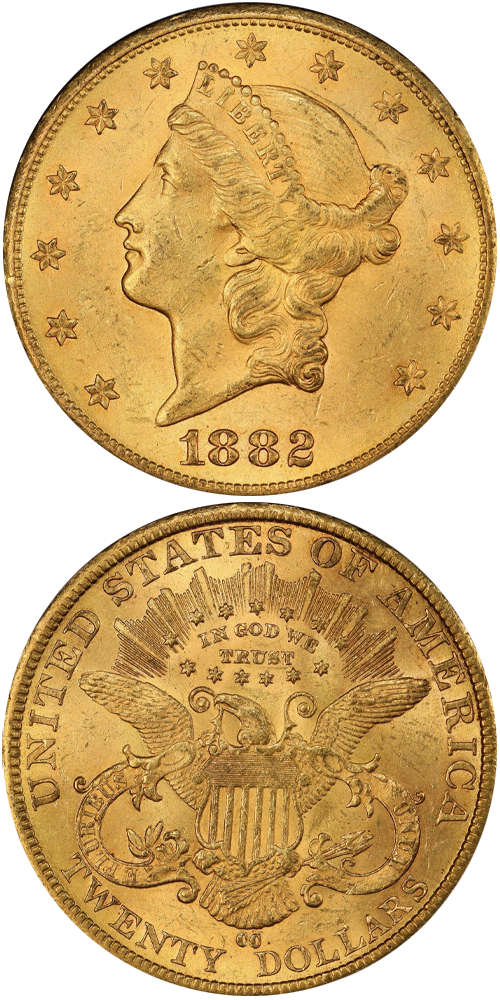1882-CC Liberty Head Double Eagle
Jeff Ambio: The two known die marriages of the 1882-CC Liberty double eagle share neither an obverse nor reverse die. On the obverse of Winter 2-B, the date is large, set low in the field, and is closer to the denticles than the truncation of Liberty's neck. The CC mintmark on the reverse leans slightly to the viewer's left with the first C lower than the second. The first C is centered between the words TWENTY and DOLLARS and the right edge of the second C is centered over the upright of the letter D in DOLLARS.
Rusty Goe: Coiner Levi Dague's department at the Carson City Mint had not emitted a double eagle since sometime in late summer or early fall of 1879. The Philadelphia and San Francisco facilities had produced double eagles between then and the end of 1881, albeit in smaller quantities than usual. The Treasury Department, under Secretary John Sherman, had initiated a policy, beginning in late 1879 and carrying through for several years, whereby it would expand the production of gold denominations smaller than twenty dollars. This in turn led to a reduction in the emission of double eagles. The Carson Mint's output of the large gold coins had diminished so much by the time the Treasury had implemented its new policy that it would not have mattered what course the Department had chosen to take. Steadily declining bullion deposits had reduced the Carson branch's turnout of gold coins, especially the double eagles; the Treasury's policy only served to put a lid on production.
The Carson City Mint struck 3,000 double eagles in January, the first examples of that denomination that had come from Dague's department in over 26 months. By the end of April 12,600 double eagles had been produced, more than the annual total back in 1879. Of those first runs in 1882, the chief cashier had said that 3,565 double eagles remained in the mint's vault at the beginning of May. Coiner Dague added 5,571 more between May and June and then paused for annual cleanup time.
In the second half of the year, the pace picked up slightly, and by the end of December, another 20,969 $20 gold pieces were delivered. This brought the total for 1882 to 39,140; but more important, thanks to the added boost provided by an unprecedented production of half eagles, the face value of gold coinage minted in Carson City almost quadrupled from 1881's figure.
The overall quality of the double eagles, which had improved significantly in 1877, continued to do so in 1882. We can see this on the examples that survive today (save for the typically bagmarked surfaces of course). Presently, the survival rate stands at about four percent of the original mintage.
Q. David Bowers: From the 1882-CC double eagle mintage, I suggest that there are 1,200 or so circulated examples in numismatic circles and 40 to 60 in Mint State, the latter nearly all hovering around MS-60 to 62. In this context the Battle Born Collection MS-63 is remarkable indeed.
Among circulated examples, coins in the EF and AU categories outnumber those in the VF range, as by this time many Carson City double eagles were exported after having received only slight use in circulation -- in contrast to Carson City coins of a decade earlier which were mainly used stateside or were shipped overseas only after having received considerable wear in domestic commerce.
The example to the left was sold by Stack's Bowers Galleries in the Fairmont Collection, Hendricks Set, where it realized $156,000.






